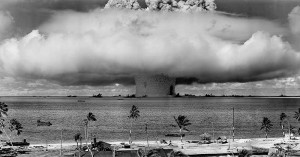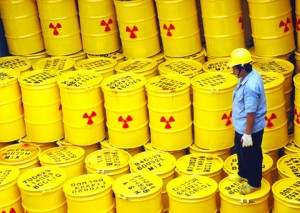The development and implementation of nuclear energy programs has proved to be a double edged sword. Although harvesting the potential energy of nuclear fissions original intention served to gain advantage in war, scientists shifted their aims to utilize nuclear power as an energy source. Nuclear energy is not only more efficient than fossil fuels, but also proves much less harm to the atmosphere. Governments, unaware of the potential consequences of running large nuclear power plants (NPPs), installed them primarily in Russia, the United States, France, Germany, and Japan. The immediate consequences of NPPs remained practically non-existent—experts knew radiation exposure could be a fatal and is why nuclear arms were tested in remote, uninhabited areas. Containment and control were primary safety concerns during the establishment of NPPs, but scientists and the public failed to predict the potential consequences of nuclear energy. Due to nuclear fuel emissions, inadequate operations, and devastating nuclear disasters, the unintended ramifications of nuclear energy development manifest themselves in the form of radioactive wastes, contaminating gasses and emissions, and harmful environmental effects both on fauna, plant life, and humans.[1] Another issue scientist took into calculation but failed to control proved to be the long-term effects of fallout on the environment and humans resulting from nuclear weapons testing. Although isolated locations were chosen to execute tests for observatory purposes, nearby humans developed side effects from the draft of nuclear fallout. These include growths, irritation, ulcers, cancer and other health risks.[2]

Radiation Burns from a victim in Hiroshima.
The largest concern for nuclear weapons testing and nuclear meltdowns remains the delayed effects of fallout, or radioactive products that have settled to the ground.[3] BRAVO, a thermonuclear bomb tested above Bikini Atoll in 1954, unpredictably gave the children in the proximate Marshall Islands thyroid nodules, lesions, and lasting medial problems. The radius of destructing was thirty times what scientists estimated, and an unpredicted shift in wind patterns carried fallout over two hundred kilometers away. The skin of fisherman over eighty miles away was scorched to blistering, as white as enveloped them and contaminated their catch.[4]

BRAVO Nuclear Test
Burns are a short-term symptom, coupled with blast injuries and radiation illness. Lasting, unintended injuries plague the victims of nuclear weapons as well. Ionization radiation damages chromosomes by radioactive particles breaking up molecules and creating free radicals, which “damage DNA and disrupt cellular chemistry in other ways – producing immediate effects on active metabolic and replication processes, and long-term effects by latent damage to the genetic structure.”[5] Victims of radioactive fallout are also extremely susceptible to hair loss, due to the effects from disturbance in lymphatic tissues, blood, and the immune system, leading to continual cell division.

Hair loss from radiation
Although damage to chromosomes can heal over time, side effects can manifest themselves many years later, and it is quite possible to develop cancer due to cell division.

Thyroid Cancer
Contrary to popular belief, the genetic disturbances nuclear radiation has on human DNA rarely causes mutations due to high rates of genetic variability and uncertainty. Another reason is because high levels of exposure usually damage reproductive tissues to the point of sterilization, which prevents the transmission of genetic defects.[6] These fallout effects are not exclusive to nuclear weapons testing and use; they are also a product of large-scale nuclear accidents.

Birth defects as a result of Chernobyl
In 1989, reactor four of the infamous Chernobyl nuclear power plant experienced a melt down due to improper management. The Chernobyl nuclear catastrophe in 1986 introduced extremely large amounts of radioactive waste into the atmosphere, which continue to have unpredicted consequences throughout the Soviet Union and Western Europe.

Nuclear Reactor 4 Meltdown at Chernnobyl
Effects on agriculture, the environment, and health risks are three of the major unintended consequences that are a byproduct of nuclear radiation fallout from large-scale nuclear accidents. The disaster destroyed forests, contaminated water supplies and had devastating effects on wildlife. Britain experienced effects from fallout a week after the disaster, resulting in a dip in the economy due to radiation in the livestock, crops, and food. [7]

Chernobyl Fallout Map
The consumption of contaminated meats and food inevitably leads to side effects, and the agricultural markets of Great Britain fell as farmers, who were hit hard by the fallout as their livestock ate plant life with radiation and became contaminated. Groundwater, and especially plant and animal life all suffered detrimentally as a result of the nuclear meltdown. Although the effects on the drinking water were seen to be generally non-threatening in the immediate aftermath due to the insolubility of the radioactive particles in water, the accumulation of radiation in fish in the nearby areas made them too dangerous to eat. The famous “Red Forest” is a direct product of the Chernobyl meltdown, a four-kilometer area of woods that died after the incident.

If you look closely you can see the radiated area of the Red Forest
Due to caesium-137 particles, which were absorbed into the environment, scientists are estimating it will take roughly one hundred years to for these woods to recover.[8]The unintended human death toll due to cancer as a result of fallout rests at higher rates than most are aware of.
The Internal Agency for Research on Cancer released its estimation that 16,000 cancer deaths by the year 2065 are a result of the Chernobyl accident in the Journal of Cancer in 2006.[9] These estimations, however, wane quite significantly. The actual effects that Chernobyl fallout has had on the population is still a debated topic, with sources conflicting drastically. The most conservative estimates claim only four thousand cancer related deaths as a result of the Chernobyl meltdown, where as the higher estimates range up to 200,000. In contrast to The World Health Organization estimated that there were roughly four thousand cancer related deaths as a result of the accident, the Chernobyl Forum estimated that throughout Russia, Ukraine, and Belarus, radiation poisoning could have killed between 10,000-200,000 people.[10] The plant and wildlife in Europe was also widely affected by this disaster as well.
The animals closer to the Chernobyl accident experience many physical health issues. Many horses in the nearby area died because their thyroid glands were destroyed by radiation. Thyroid damage and thyroid cancer is a common side effect of exposure to higher doses of radiation, and inhibited the physical maturation of cattle in the nearby area as well. In Germany, 2010, one in every approximately 450 boars hunted were too radioactive to eat. In Norway, 2009, a total of 18,000 livestock had to be fed special, clean, radioactive free food until the radioactive contaminants had been purified from their systems before consumption. [11] One way of preventing future radioactive issues is by properly containing nuclear waste, making nuclear waste storage extremely important in the long term due to the long lasting nature of the radioactive particles.
Radioactive waste is an all-encompassing term, as it refers to “the leftovers from the use of nuclear materials for the production of electricity, diagnosis and treatment of disease, and other purposes.”[12] A common strategy is to reduce the volume of waste through the methods of compaction and incineration. The two different types of waste, high and low level, are handled differently. Low-level waste products such as radioactively contaminated clothes or handled items. High-level waste is primarily nuclear reactor fuel and is usually kept at nuclear power plants due to their lack of proper disposal.

High Level Nuclear Storage
Low-level wastes are placed in radioactive waste containers and are often stored at the production zone or a NPP. In order to avoid further radioactive waste leakage and prevent future environmental damage, more methods need to be developed to store nuclear waste.[13]

Low Level Waste Storage
The consequences of nuclear energy programs have been quite significant in terms of environmental and human affliction. Although scientists intended for the immediate short-term effects of nuclear weapons to take place, and even the longer ones—they did not accurately predict the impact it would leave on the environment and people resulting from theoretically harmless tests. The NPP programs were intended to be entirely harmless, but resulted in most likely tens of thousands of deaths worldwide, although that number is still being determined. Radiation leads to the destruction of water sources, environments, and society on a smaller scale. Humans have been developing cancer from the fallout, contributing to excess deaths potential, low-grade mutations and infertility, especially in zones proximate to the meltdowns. Storage of radioactive waste is still challenging scientists and the government. Its potency lasts as long as the contaminated particle remains radioactive, which is usually hundreds of years or more. It remains imperative to master the transportation and storage of nuclear waste to make our nuclear programs more sustainable. Had scientists been aware of these potential ramifications, they would have approached the development and control of the nuclear industry with more caution.
Chernobyl Disaster
[1] Wikipedia. “Environmental Impact of Nuclear Power” Last modified November 26, 2013
[2] Sublette, Carey. “Section 5.0 Effects of Nuclear Explosions”. Nuclear Weapon Archive. Last modified May 15, 1997.
[3] Sublette, Carey. “Section 5.0 Effects of Nuclear Explosions”. Nuclear Weapon Archive. Last modified May 15, 1997.
[4] Cavanaugh, Jamie, Suzie Genyk, and Emma Uman. “Environmental Impacts of Nuclear Proliferation.” University of Michigan.
[5] Sublette, Carey. “Section 5.0 Effects of Nuclear Explosions”. Nuclear Weapon Archive. Last modified May 15, 1997.
[6] Nuclear Weapons Archive.org
[7] Chris C. Park. Chernobyl: The Long Shadow (London, New York: Routledge, 97-99).
[8] Wikipedia. “Environmental Impact of Nuclear Power.” Last modified October 16, 2013.
[9] Wikipedia. “Environmental Impact of Nuclear Power.” Last modified October 16, 2013.
[10] Wikipedia. “Chernobyl Disaster.” Last modified December 12, 2013.
[11] Wikipedia. “Environmental Impact of Nuclear Power.” Last modified October 16, 2013.
[12] U.S. Nuclear Regulatory Commission. “Radioactive Waste.” Last modified February 21, 2013.
[13] U.S. Nuclear Regulatory Commission. “Radioactive Waste.” Last modified February 21, 2013.












